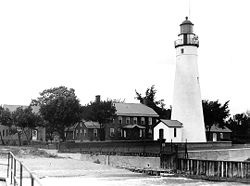Fort Gratiot Light
 |
|
| Location | Omar and Garfield Sts., Port Huron, Michigan |
|---|---|
| Coordinates | 43°0′22.7″N 82°25′20.9″W / 43.006306°N 82.422472°WCoordinates: 43°0′22.7″N 82°25′20.9″W / 43.006306°N 82.422472°W |
| Year first constructed | 1825 |
| Year first lit | 1825 |
| Automated | 1933 |
| Foundation | Dressed stone and timber |
| Construction | Brick |
| Tower shape | Frustum of a cone attached to workroom |
| Markings / pattern | White |
| Height | Tower – 85 feet (26 m) |
| Focal height | Focal plane – 82 feet (25 m) |
| Original lens | Fourth-order Fresnel lens |
| Current lens | DCB-24 Carlisle & Finch Aerobeacon |
| Range | 21 nautical miles (39 km; 24 mi) |
| Characteristic | Fl green 6 seconds |
| Fog signal | Station will give available information on fog conditions in upper river by radiotelephone when requested, (156.80 MHz). Standby light of reduced intensity lighted throughout 24 hours. |
| ARLHS number | USA-291 |
| USCG number |
7-1001 |
|
Fort Gratiot Lighthouse
|
|

Undated USCG image
|
|
| Area | less than one acre |
| Architect | Lyon, Lucius; Moors, J. |
| NRHP reference # | 76001975 |
| Added to NRHP | July 30, 1976 |
| Heritage | place listed on the National Register of Historic Places |
|
[]
|
|
7-1001
Fort Gratiot Light, the first lighthouse in the state of Michigan, was constructed north of Fort Gratiot in 1829 by Lucius Lyon, who later became one of Michigan's first U.S. Senators.
The Fort Gratiot Light marks the entrance to the St. Clair River from Lake Huron (going south) in the southern portion of Michigan's Thumb. The light is still active and the grounds are an active Coast Guard facility, but it has recently been handed over to the Port Huron Museum. It is the oldest surviving lighthouse in Michigan. There is also a public beach and park on the property, known as Lighthouse Beach.
It is across the river from Point Edward Front Range Light.
With the completion of the Erie Canal, traffic in the Great Lakes increased dramatically. Coal was being brought from Michigan, stone (and more timber) was being brought from Wisconsin and the entrance to the St. Clair River became a bottleneck. In 1823, Congress appropriated $3,500 to construct a light in "Michigan Territory" near Fort Gratiot.
The contract for construction of the lighthouse and keeper's dwelling was awarded to Captain Winslow Lewis of Massachusetts. Lewis was the inventor of the patented Lewis lamp, which the Fifth Auditor had universally adopted as the primary source of illumination in the nation's growing inventory of lighthouses. A staunch supporter and ally of the Fifth Auditor, Lewis had branched out into the business of lighthouse construction, and as the frequent low bidder, was being awarded a growing number of contracts to fulfill the nation's need for navigational aids on the East Coast.
Lewis sub-contracted the construction of the tower and keeper's dwelling that would become known as the "Fort Gratiot Light" to Daniel Warren of Rochester, New York. Work commenced on the structure, but appears to have been running far beyond the scope of the original bid, since Congress appropriated an additional $5,000 for the project's completion on April 2, 1825.
Even with the major cost overrun, it became quickly apparent that the structure was both poorly designed and constructed. George McDougall, a former Detroit lawyer of some ill repute was selected as the light's first official keeper. McDougall's reports indicated that the stairs were so steep that they had to be climbed sideways, and the trapdoor into the lantern room was barely large enough for a man to squeeze through. While McDougall no doubt reported with truth on this situation, he was reputedly a short man with a weight in excess of 300 pounds, and as such hired an assistant to perform all of his tower work.
...
Wikipedia

